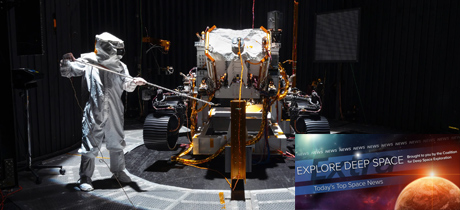In Today’s Deep Space Extra… Spacewalking NASA astronauts prepare the Space Station for the arrival of a commercial airlock later this year. NASA studies procedures for future Private Astronaut Missions to the International Space Station (ISS). The European Commission curtails a seven year space budget due to the coronavirus pandemic.
Human Space Exploration
Spacewalkers prep Space Station for future upgrades
Coalition Member in the News – NanoRacks
Spaceflightnow.com (7/21): NASA astronauts Chris Cassidy and Bob Behnken strolled through their fourth spacewalk within a month outside the International Space Station (ISS) on Tuesday. A major focus was preparing the Station’s U.S. segment Node 3 Tranquility module for the arrival of a NanoRacks’ commercial airlock later this year. They also installed a tool chest for the storage of robotic sensors capable of detecting ammonia coolant leaks and removed latches from two solar truss modules to prepare for future solar array upgrades. During three previous spacewalks on July 16, July 1 and June 26, the two astronauts completed a 3 1/2 year effort to upgrade solar power system batteries.
NASA seeking info on liability approaches for Private Astronaut Missions to ISS
Executivegov.com (7/20): NASA has issued a Request for Information from potential Private Astronaut Mission launch service providers and insurance companies. Currently, NASA is developing a strategy to ensure compliance by private mission planners with astronaut training, spacecraft proximity operations and docking activity requirements while preparing to visit the International Space Station (ISS) as well as live and work aboard the orbiting science laboratory.
Space Science
China’s first Mars rover Tianwen-1 launches this week. Here’s what it will do
Space.com (7/21): China’s Tianwen-1 Mars mission is one of three U. S., United Arab Emirates (UAE) and Chinese missions launching to the Red Planet during a favorable alignment with the Earth that extends into August. A research paper published in the journal Nature Astronomy examines the objectives of China’s combined orbiter, lander and rover mission. With a launch as soon as Thursday, Tianwen-1 should reach Mars in February. The lander is to descend into the same region explored by NASA’s Viking 2 lander in 1976. It’s all about searching for evidence of a past habitable environment and perhaps past life on Mars.
How NASA built a self-driving car for its next Mars mission
Wired.com (7/21): Philip Two, of NASA’s Jet Propulsion Laboratory (JPL), explains the self-driving car features of NASA’s Perseverance Mars 2020 rover, which is due to launch to the Red Planet on July 30. After a planned February 2021 landing, the rover is to gather samples of soil and rock at Jezero Crater and an adjacent ancient river delta. The samples are to be cached and returned to Earth by a future mission. Unlike its predecessors, Perseverance’s main computer is accompanied by a second machine vision computer to help it navigate unexplored and perhaps rugged terrain, all in 3-D, without stopping and starting.
Chandrayaan 2’s data release will include the highest-resolution 3D map of the Moon and information from its 8 high tech instruments
Business Insider (7/22): The India Space Research Organization (ISRO) has announced plans to release high resolution imagery of the lunar surface gathered by the Chandrayaan-2 mission. The release is to begin in October. The lunar orbiting spacecraft was launched July 22, 2019 and is perhaps best remembered for a loss of contact when its Vikram lander and Pragyan rover attempted to soft land at the Moon’s south pole on September 7, 2019.
Comet Neowise has begun to dim, so catch it while you can
Washington Post (7/21): Comet Neowise, which only recently became naked eye visible in the night sky after sunset, is beginning to dim as it journeys away from the sun. By August, the comet discovered in March will have sped away towards the outer solar system, becoming too far to spot with the naked eye.
Other News
European Commission agrees to reduced space budget
SpaceNews.com (7/21): The COVID-19 pandemic has taken a toll in Europe on spending for space. The European Commission slashed its space budget for the next seven years, agreeing to a maximum of 13.2 billion ($15.2 billion) focused mainly on continuing the Galileo satellite navigation and Copernicus environmental monitoring initiatives.

